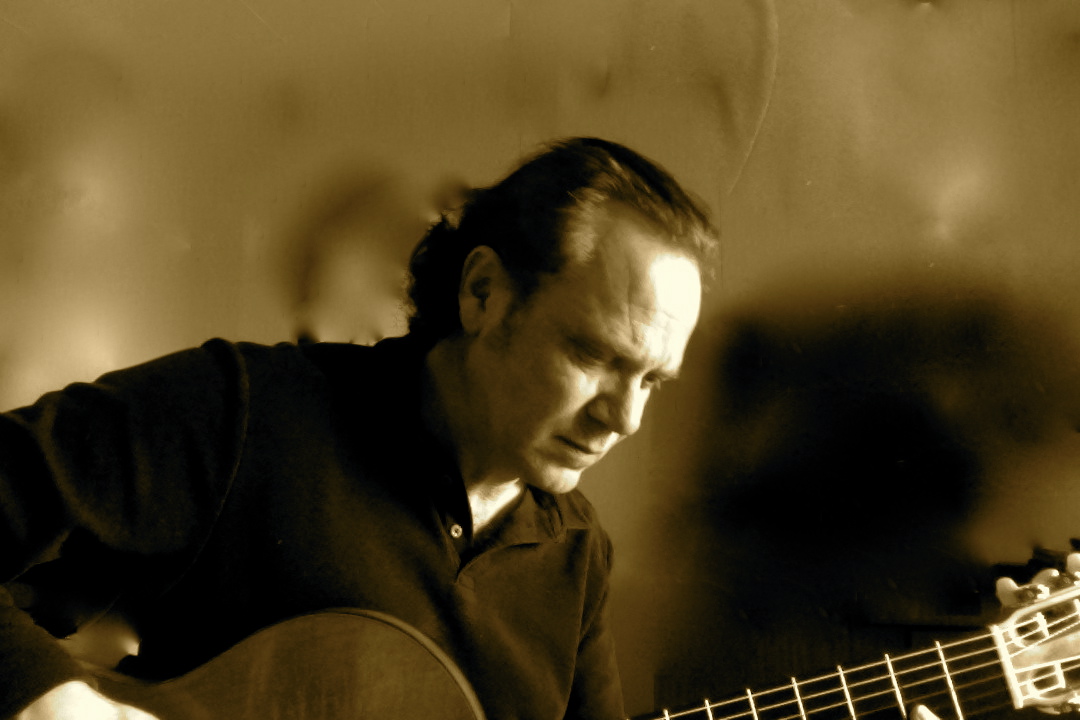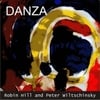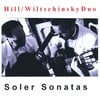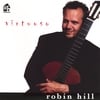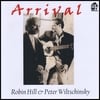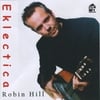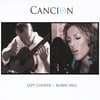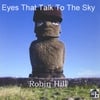I was absolutely delighted when 'Danza' by The Hill/Wiltschinsky Guitar duo, became available for us to re-release.
Initially recorded and distributed by ASV back in 1995, it had however never been digitally available, so now was our chance to rectify this.
I was also very pleased because this CD happens to be one that means a lot to me.
At the time of its release I was frequently travelling with the duo, as Robin and I were yet to have children... and therefore have seen and heard most of these tracks performed in concert venues around the world.
Before I add a contemporary review of 'Danza' from 'Classical Guitar Magazine' and the eloquent and detailed sleeve notes from the original release, written by Graham Wade, I wanted to add a little inside information.
For example, Tracks 20 is the fabulous, 'Corta Jaca' by Radames Gnattali, taken from the Retratos Suite, this is a stunning piece based on the samba rhythm.
At the time the music was unavailable but the duo were desperate to play it. So, determined as ever, Robin listened to the only recording available and took down the notes one at a time.
As you hear the piece you will realise just what an undertaking this was!
But, worth all the effort as they gave many fabulous performances along with this recording.
I also wanted to mention the, 'Suite Italiana' by Mario Gangi.
Gangi had heard a recording of the duo playing another of his pieces, 'Suite Spagnola' and was so pleased with their interpretation that he composed the 'Suite Italiana' especially for them.
One review at the time of an important concert by the Duo at Rome's Sistine Theatre, in homage to Andres Segovia, mentions that the journalist involved happened to be seated next to Maestro Gangi and that Gangi was, "hardly able to hide his satisfaction for the lovely performance."
'Espagne', composed by the brilliant French guitarist Ida Presti, is the world premiere recording of this piece. The duo, having heard a tape recording of an old radio performance by the Presti and Lagoya Duo, were keen to record and perform this neglected masterpiece. It provides a spectacular demonstration of guitar virtuosity and compositional inventiveness.
The final piece I would like to mention is Robin's own composition, 'Tre Esercizi' (dedicated to Mario Gangi in reciprocity for the Suite Italiana) comprises three movements, Tarantella in E minor (track 8), Canzone in F (track 9) and Giga in A minor (track 10).
The review below, from 'Classical Guitar' states that 'Canzone' contains, "one of those compulsive melodic lines we all wish we'd written ourselves," but it's the, Giga in A minor that I want to highlight.
The main reason being that when performing this in concert Peter Wiltschinsky always introduced this as being, "One of the most difficult pieces we play," which always induced a little laughter from the audience and a sense of trepidation as the music began.
I recall the tension I felt as I played every note in my head alongside the duo, willing them to get through the difficult passages!
They always did.
You can find 'Danza' on iTunes, Amazon, CD Baby and many other digital outlets.
Below are the original review and sleeve notes.
DANZA - REVIEW - 'CLASSICAL GUITAR MAGAZINE'
A new release from the Hill-Wiltschinsky Duo is always a cause for celebration, and DANZA is no exception. From the opening bars of the Giuliani to the triumphant conclusion of Gnattali's brilliant Corta Jaca, this world class team remain on their very best form. Even the modest lute duets are despatched with a sense of style and grandeur which belies their relatively humble stature.
It is, however, the premiere recording of Presti's Espagne which makes this release such a major event. A momentous discovery by any standards, it will remain forever a mystery why this seven minute Fallaesque fantasia was never taken into the studio by its creator and has languished in obscurity since her death in 1967. Rich in texture and strong in thematic material, it is surely fitting that this neglected masterpiece has finally been adopted by one of the present generation's finest pair. Needless to say, the performance leaves nothing to the imagination - Espagne is typical of the colourful and energetic repertoire in which the Hill-Wiltschinsky Duo always excel.
Elsewhere, the situation remains equally impressive. Robin Hill's recently published Tre Esercizi are marvellously sophisticated miniatures, the central Canzone containing one of those compulsive melodic lines we all wish we'd written ourselves. More introspective is Peter Wiltschinsky's gently seductive Nocturne - a strategically placed moment of contemplation before the boisterous jota-based Danza.
All these delights together with the old favourites from Gangi and Vivaldi make this a CD of which no collection should be deprived.
By Paul Fowles
SLEEVE NOTES BY GRAHAM WADE:
MAURO GIULIANI (1781-1828)
TRE POLONESI CONCERTANTI, Op.137
Giuliani was one of the most celebrated guitarists of the early nineteenth century and his achievement in the realm of composition for the instrument ranks with that of Fernando Sor. Giuliani was a prolific composer and wrote a wide variety of works for guitar including concertos, sets of variations, studies, songs, exercises, chamber music, as well as some pieces for duo. A significant part of his career was spent in Vienna where he was well acquainted with Beethoven, Moscheles, Hummel and other leading musicians. In Italy he knew both Paganini and Rossini and may have performed concerts in their company.
The polonaise appeared in the Renaissance under the title of 'polacca' or 'polnischer tanz'. In the seventeenth century the French term 'polonaise' was used for pieces of Polish style or origin and over some decades this evolved into a professional dance faster than a sarabande but slower than a minuet. As an expressive musical form the polonaise was transformed for ever by Chopin whose genius enriched and elevated the concept in eleven spectacular works for pianoforte between 1817 and 1830.
The three polonaises for two guitars Op.137 were published seven years after Giuliani's death by Ricordi of Milan. The Italian composer's approach to the polonaise is concise and energetic, each of the three allegretto pieces having a contrasting Trio section. Rather than the extended polonaise-fantaisie concept of Chopin, Giuliani offers an integrated group of short polonaises, exploring the rhythmic and lyrical implications of this dance through the medium of the guitar duo.
FOUR ELIZABETHAN LUTE DUETS
One special aspect of music during the reign of Elizabeth I was the variety of ensemble music. The lute duet was especially popular and John Johnson was one of the first to compose for two lutes in an integrated way, both parts being of equal importance in melodic and harmonic material. Johnson became court lutenist to Queen Elizabeth, and was one of the earliest of the great lute composers of the 'golden age'.
The pavan (also known as pavane, pavana, paduana, and pavin) was the slowest, most stately dance of the Renaissance. It was customary after 1550 to pair the dignified pavan with the more lively galliard, a dance of Italian origin, in fast triple time, involving the dancer in energetic leaping steps. In The Flat Pavan, 'flat' indicates not that the music is out of tune but hat it is in a minor key.
The Fancy or Fantasy, was a form which displayed a composer's contrapuntal skills. Thomas Morley said that, 'in this may more art be shown than in any other music because the composer is tied to nothing but that he may add, diminish, and alter at his pleasure'.
Finally A Merry Mood is a moment of exuberance, a very different mood from the melancholy seriousness often associated with the English lutenists.
ROBIN HILL
TRE ESERCIZI
These 'Three Exercises', dedicated to Mario Gangi, evoke the moods and colours of Italian music through the eyes and ears of an English composer.
Tarantella in E minor pays homage to the lively dance from southern Italy where the port of Taranto has given its name to a spider found in the surrounding countryside, the tarantula. The bite of this spider was believed for centuries to be poisonous, causing an ailment known as Tarantism, an illness which could only be dispelled by the antidote of a lively dance, the tarantella.
The Canzone, originally a poem of the troubadour era, later became the title for a musical setting of a poem or an instrumental piece with a distinct melody.
Finally Giga concludes the triptych with a dance, the Jig, believed to have originated in the British Isles before becoming popular throughout Europe.
PETER WILTSCHINSKY
TWO PIECES
These two pieces are dedicated to the memory of the great Paraguayan guitarist and composer, Agustin Barrios Mangore. The first, Nocturne (written 1993), conjures up the shades of night with a reflective and lyrical atmosphere. It is in the key of G minor with a contrasting middle section in G major.
Danza (Jota), in the key of A major, is a virtuosic movement with its energetic variations based on the jota dance of the regions of Aragon and Navarre in northern Spain. The jota has been called the 'father of Spanish dances' and its origins may stretch into antiquity. It is in triple time, and the dance itself is characterised by swift leaps into the air demanding great physical strength and facility.
ANTONIO VIVALDI (1678-1741)
PRELUDIO & CORRENTE
Vivaldi was a much neglected composer until the twentieth century was well advanced when considerable research and catalogue of his works, along with a gradual recording of most of his output, established him as one of the greatest of all Baroque composers. He composed 46 operas (of which 21 are extant), 344 solo concertos, 81 concertos for two or more solo instruments, 61 sinfonias, 93 sonatas and trios, as well as many motets, liturgical works, oratorios, etc.
Preludio & Corrente were arranged for two guitars by Len Williams in the mid 1950s. The two contrasting pieces soon became very popular among guitarists and have remained so ever since. The movements are taken from Sonata in D minor, Op.1 No 8, (RV64, P1/8, M. 389) for two violins and cello (or harpsichord).
MARIO GANGI (1918-2010)
SUITE ITALIANA
Mario Gangi, Professor of guitar at the Rome Conservatoire, is known internationally as a prolific editor and arranger of music for guitar. Suite Italiana was written especially for the Hill-Wiltschinsky Duo in 1988. The Saltarello is a very lively dance in triple time, deriving its name from the Italian word 'saltare', to jump, and according to a note by the composer, inspired by an anonymous saltarello of Rome. The other movements are Melodia, evoking the warmth of a Mediterranean song from the area of Abruzzi, while Tarantella makes reference to a theme from the opera La festa di Piedigrotta (composed 1852) by the Neapolitan, Luigi Ricci (1805-1859), who wrote some 30 operas.
IDA PRESTI (1924-1967)
ESPAGNE
Ida Presti was a remarkable child prodigy of the guitar, who gave her first public recital at the age of eight. In 1955 she formed a guitar duo with her husband, Alexandre Lagoya, and their work together founded new traditions of excellence in this kind of ensemble which continue to inspire later generations of players. Presti was also an accomplished composer, though her works are not widely known.
Espagne has never been recorded previously and its inclusion here offer new insights into her remarkable creativity.
RADAMES GNATTALI (1906-1988)
TWO PIECES
Radames Gnattali was one of the great figures of Brazilian music in this century, composing both popular and classical music, and teaching many of the leading musicians of his country including Jobim, Bonfa, Gilberto, etc. His suite Retratos (Portraits), from which these two pieces were taken, was composed in 1957. The Schottisch is a kind of round dance or slow polka while Corta Jaca is based on the rhythms of the samba.
By Graham Wade
Reviews
'As always, it was sheer pleasure to observe Robin Hill's remarkable fluent technique: everything looks easy when he plays it.' Colin Cooper- Classical Guitar Magazine -----
'Wonderful for their (Hill & Wiltschinsky) precision, touch and clarity of sound... refined virtuosity, the achievement of a long interpretive process.' Il Giornale D'Italia (Rome) -----
'I loved your CD and thought your technique and performance were fabulous...' Rick Wakeman
Wednesday, October 02, 2013
Danza - Robin Hill & Peter Wiltschinsky
Friday, June 28, 2013
A Little Nostalgia & some Musical Inspiration - Robin Hill
Often we are asked about Robin's musical influences, and as a performer and a composer, are there particular pieces of music that helped shape the musician he is today?
Generally people seem interested in the music that has inspired a musician, especially one who unusually is equally at home on both classical & electric guitar...
So, I thought I'd address this here today.
A commonly quoted sentence in our house is, 'Nothing is composed in a vacuum,' and this became my starting point.
I have in fact touched on this before in the post, 'Miles Davis, Stravinsky, Herrmann and The Beatles - A Musical Connection' but felt it worthy of revisiting.
At the time of writing Robin had just left on a two week trip, so he obliged by sending me an email containing the names of his major musical influences from the 1930's to the 1960's.
Miles Davis featured once again, not only as Charlie Parker's sideman but also as bandleader and pioneer of 'cool jazz'.
Given that Robin is a guitarist, it won't come as a surprise that the album, 'Sketches of Spain', was high on his list with its highly original arrangement by Gil Evans of the Adagio from Rodrigo's Concierto de Aranjuez.
Davis thought the melody was so strong that, 'The softer you play it, the stronger it gets,' and although there were critics, I feel it is an excellent example of different genres of music creating a most sublime synergy.
Then there's Benny Goodman.
A jazz clarinetist and band leader with the facility to play anything from swing jazz to Mozart concertos. In fact, Bela Bartok, one of the most important composers of the 20th century, actually composed a piece for Goodman, 'Contrastes'. Again showing the interaction and inter relation of many musical styles.
Two albums by the American bandleader, double bassist and composer, Charlie Mingus, also got a mention. 'Blues & Roots', recorded in 1959 and released in 1960, Mingus revisits his early musical experiences, mainly the blues, gospel and New Orleans Jazz.
It's reported that the recording sessions were rather disorganised but the result is that each track has a loose and relaxed feel.
The second album, 'Mingus Ah Um', also recorded in 1959 has had such an impact on the world that it was one of only fifty recordings added to the Recording Registry in 2003. An amazing album which can't help but draw the listener into the mood. Particularly the track, 'Better Git it in Your Soul', which, especially if listened to with eyes closed, paints a vivid and exciting portrait of New York City in the late 1950s..
Before we leave the jazz scene, which was so seminal in this era, one has to mention Django Reinhardt, particularly if examining the musical influences and inspirations of a guitarist.
Reinhardt was one of the first major European jazz musicians. The fact that he could only use the first and middle fingers of his left hand (due to injury in a fire at the age of 18) didn't hinder him. He simply invented a new technique of playing which has become a tradition in French gypsy culture.
One of his most memorable and enduring musical collaborations was with Stephane Grappelli, an association which produced not only great music but also some amusing episodes, one of which I wrote about here, 'Django Reinhardt, Stephane Grappelli & the Revolving Stage'.
It's telling that many years after these musicians were performing, Robin was, and still is, influenced by their music.
Whilst he may have started out in the field of classical music, one influences the other, and it's no coincidence that some time later he was recording his own jazz quartet, Eklectica', you can read about them here in, 'Robin Hill Plays Claude Bolling's 'Concerto for Classic Guitar and Jazz Piano Trio'.
But jazz wasn't his only influence, no classical guitarist forms a career without being hugely influenced by the presence of Andres Segovia, whose own career spanned all the decades we are looking at and more besides.
In fact the blog post, 'Hill/Wiltschinsky Guitar Duo Pay Homage to Andres Segovia', describes how the duo had the tremendous honour of being asked to perform a special concert in memory of Segovia in the Sistine Theatre, Rome.
Another highly influential and original artist and composer is George Gershwin, an American composer of both popular and classical music with a huge back catalogue including, 'An American in Paris', 'Rhapsody in Blue' and 'Porgy and Bess'.
His ability to cross genres is truly special and recognised by musicians in all camps. One of his sincerest admirers being Maurice Ravel. His two piano concertos are influenced by Gershwin and, in turn, much of Gershwin's orchestral work contains distant echoes of Ravel. Both of these composers had imaginatively captured the zeitgeist of their epoch in different ways which were mutually inspirational.
Again, from Robin's perspective all the above can be heard in some of his concerti. Particularly, 'Concerto Primavera - Robin Hill', and 'Arrival on iTunes and Eternal Dance-Robin Hill'.
However, there is a whole other side to Robin's musicianship and one that is quite unusual for classically trained musicians.
He is also known for his electric guitar playing and has been in various bands over the years, starting at the tender age of 12, and later performing with established bands such as Jethro Tull and Deep Purple, as a session guitarist with too many artists to mention here and his own bands, Hooper, Spring and Force 10.
He had no hesitation in listing the bands that had influenced him in his youth and completed his early training in musical styles.
The Beatles had to be there, right from, 'With The Beatles' to 'Sergeant Pepper', Frank Zappa with, 'Hot Rats, Jimi Hendrix with practically every note he played, The Beach Boys, particularly the track, 'Good Vibrations' and The Kinks, 'Waterloo Sunset' and ‘You Really Got Me’…which, interestingly features Deep Purple’s Jon Lord on piano.
The interesting part of this musical jigsaw is that all the different styles I have been looking at are still prevalent in Robin's life today. He regularly listens to them all, and many, many more and their endurance shows the quality of their musical history.
He continues to look out for, and listen to, new music and old and still creates his own.
Currently he has returned to his band roots and is working on an electric rock/blues style album.
Two of the tracks can already be heard, 'Illegal Download Blues & 38459', and having read the history, you may well see some of the above influences shining through.
As I said at the beginning, nothing is composed in a vacuum. Every musician listens, learns and incorporates this knowledge into their own music, whether original compositions or interpretations.
This is why it is so important not to be bound by one style alone. Take a chance and investigate the unknown.
We have always felt it essential to expose our children to as many different types of music as possible. Actually, they didn't have an option, music has been available to them since before they were actually born.
But it is an essential part of learning and one we take seriously. Children are the next generations of musicians and it's our role to ensure they are inspired. In fact, 'Inspire Young Minds with Music'.
Generally people seem interested in the music that has inspired a musician, especially one who unusually is equally at home on both classical & electric guitar...
So, I thought I'd address this here today.
A commonly quoted sentence in our house is, 'Nothing is composed in a vacuum,' and this became my starting point.
I have in fact touched on this before in the post, 'Miles Davis, Stravinsky, Herrmann and The Beatles - A Musical Connection' but felt it worthy of revisiting.
At the time of writing Robin had just left on a two week trip, so he obliged by sending me an email containing the names of his major musical influences from the 1930's to the 1960's.
Miles Davis featured once again, not only as Charlie Parker's sideman but also as bandleader and pioneer of 'cool jazz'.
Given that Robin is a guitarist, it won't come as a surprise that the album, 'Sketches of Spain', was high on his list with its highly original arrangement by Gil Evans of the Adagio from Rodrigo's Concierto de Aranjuez.
Davis thought the melody was so strong that, 'The softer you play it, the stronger it gets,' and although there were critics, I feel it is an excellent example of different genres of music creating a most sublime synergy.
Then there's Benny Goodman.
A jazz clarinetist and band leader with the facility to play anything from swing jazz to Mozart concertos. In fact, Bela Bartok, one of the most important composers of the 20th century, actually composed a piece for Goodman, 'Contrastes'. Again showing the interaction and inter relation of many musical styles.
Two albums by the American bandleader, double bassist and composer, Charlie Mingus, also got a mention. 'Blues & Roots', recorded in 1959 and released in 1960, Mingus revisits his early musical experiences, mainly the blues, gospel and New Orleans Jazz.
It's reported that the recording sessions were rather disorganised but the result is that each track has a loose and relaxed feel.
The second album, 'Mingus Ah Um', also recorded in 1959 has had such an impact on the world that it was one of only fifty recordings added to the Recording Registry in 2003. An amazing album which can't help but draw the listener into the mood. Particularly the track, 'Better Git it in Your Soul', which, especially if listened to with eyes closed, paints a vivid and exciting portrait of New York City in the late 1950s..
Before we leave the jazz scene, which was so seminal in this era, one has to mention Django Reinhardt, particularly if examining the musical influences and inspirations of a guitarist.
Reinhardt was one of the first major European jazz musicians. The fact that he could only use the first and middle fingers of his left hand (due to injury in a fire at the age of 18) didn't hinder him. He simply invented a new technique of playing which has become a tradition in French gypsy culture.
One of his most memorable and enduring musical collaborations was with Stephane Grappelli, an association which produced not only great music but also some amusing episodes, one of which I wrote about here, 'Django Reinhardt, Stephane Grappelli & the Revolving Stage'.
It's telling that many years after these musicians were performing, Robin was, and still is, influenced by their music.
Whilst he may have started out in the field of classical music, one influences the other, and it's no coincidence that some time later he was recording his own jazz quartet, Eklectica', you can read about them here in, 'Robin Hill Plays Claude Bolling's 'Concerto for Classic Guitar and Jazz Piano Trio'.
But jazz wasn't his only influence, no classical guitarist forms a career without being hugely influenced by the presence of Andres Segovia, whose own career spanned all the decades we are looking at and more besides.
In fact the blog post, 'Hill/Wiltschinsky Guitar Duo Pay Homage to Andres Segovia', describes how the duo had the tremendous honour of being asked to perform a special concert in memory of Segovia in the Sistine Theatre, Rome.
Another highly influential and original artist and composer is George Gershwin, an American composer of both popular and classical music with a huge back catalogue including, 'An American in Paris', 'Rhapsody in Blue' and 'Porgy and Bess'.
His ability to cross genres is truly special and recognised by musicians in all camps. One of his sincerest admirers being Maurice Ravel. His two piano concertos are influenced by Gershwin and, in turn, much of Gershwin's orchestral work contains distant echoes of Ravel. Both of these composers had imaginatively captured the zeitgeist of their epoch in different ways which were mutually inspirational.
Again, from Robin's perspective all the above can be heard in some of his concerti. Particularly, 'Concerto Primavera - Robin Hill', and 'Arrival on iTunes and Eternal Dance-Robin Hill'.
However, there is a whole other side to Robin's musicianship and one that is quite unusual for classically trained musicians.
He is also known for his electric guitar playing and has been in various bands over the years, starting at the tender age of 12, and later performing with established bands such as Jethro Tull and Deep Purple, as a session guitarist with too many artists to mention here and his own bands, Hooper, Spring and Force 10.
He had no hesitation in listing the bands that had influenced him in his youth and completed his early training in musical styles.
The Beatles had to be there, right from, 'With The Beatles' to 'Sergeant Pepper', Frank Zappa with, 'Hot Rats, Jimi Hendrix with practically every note he played, The Beach Boys, particularly the track, 'Good Vibrations' and The Kinks, 'Waterloo Sunset' and ‘You Really Got Me’…which, interestingly features Deep Purple’s Jon Lord on piano.
The interesting part of this musical jigsaw is that all the different styles I have been looking at are still prevalent in Robin's life today. He regularly listens to them all, and many, many more and their endurance shows the quality of their musical history.
He continues to look out for, and listen to, new music and old and still creates his own.
Currently he has returned to his band roots and is working on an electric rock/blues style album.
Two of the tracks can already be heard, 'Illegal Download Blues & 38459', and having read the history, you may well see some of the above influences shining through.
As I said at the beginning, nothing is composed in a vacuum. Every musician listens, learns and incorporates this knowledge into their own music, whether original compositions or interpretations.
This is why it is so important not to be bound by one style alone. Take a chance and investigate the unknown.
We have always felt it essential to expose our children to as many different types of music as possible. Actually, they didn't have an option, music has been available to them since before they were actually born.
But it is an essential part of learning and one we take seriously. Children are the next generations of musicians and it's our role to ensure they are inspired. In fact, 'Inspire Young Minds with Music'.
Tuesday, February 12, 2013
Illegal Download Blues & 38459 - New tracks by Robin Hill
These newly-released tracks represent a very different facet of Robin's eclectic musical personality (he's singing and playing electric guitar and keyboard on these!)
For many years Robin has been associated with the world of classical music but he has in fact played and sung in many bands, and worked as a session musician with some of the finest around.
It was a simple dinner party that provided the catalyst for Robin to return to his rock and blues roots.
When the conversation touched on illegal downloads of music and films, Robin, as the only musician present, felt he had to voice his opinions and stand his corner.
He quoted Pete Townshend's thoughts on the subject, "If you illegally download my music you might as well come round to my house and steal my kid's bike."
He also made the very salient point that other people are making money from illegal downloads.
He thought his feelings could be most articulately, and appropriately, expressed via the blues...hence "Illegal Download Blues" a slightly tongue in cheek but, nevertheless, emotional and heartfelt song...
Having written this track he decided it would be an interesting and enjoyable challenge to record a whole album of songs...the next to appear was "38459" a funky kind of rock song.
Many more are now in the pipeline and an album will surely follow.......
As it says at the end of the video, "This track is dedicated to the creative industries everywhere whose livelihoods are diminished by piracy."
Both tracks are now available from iTunes, Amazon, CD Baby and many other digital outlets.
Enjoy the video for, 'Illegal Download Blues,'then have a listen to, '38459', you have to hear Vanessa Haynes on backing vocals...
For many years Robin has been associated with the world of classical music but he has in fact played and sung in many bands, and worked as a session musician with some of the finest around.
It was a simple dinner party that provided the catalyst for Robin to return to his rock and blues roots.
When the conversation touched on illegal downloads of music and films, Robin, as the only musician present, felt he had to voice his opinions and stand his corner.
He quoted Pete Townshend's thoughts on the subject, "If you illegally download my music you might as well come round to my house and steal my kid's bike."
He also made the very salient point that other people are making money from illegal downloads.
He thought his feelings could be most articulately, and appropriately, expressed via the blues...hence "Illegal Download Blues" a slightly tongue in cheek but, nevertheless, emotional and heartfelt song...
Having written this track he decided it would be an interesting and enjoyable challenge to record a whole album of songs...the next to appear was "38459" a funky kind of rock song.
Many more are now in the pipeline and an album will surely follow.......
As it says at the end of the video, "This track is dedicated to the creative industries everywhere whose livelihoods are diminished by piracy."
Both tracks are now available from iTunes, Amazon, CD Baby and many other digital outlets.
Enjoy the video for, 'Illegal Download Blues,'then have a listen to, '38459', you have to hear Vanessa Haynes on backing vocals...
Labels:
authors,
blues guitar,
Fender Stratocaster,
filmmakers,
game makers,
guitar,
MCPS,
Musicians,
Pete Townshend,
photographers,
piracy,
PPL,
PRS,
recording industry,
Robin Hill,
software developers,
writers
Subscribe to:
Posts (Atom)
